#wheelchair
Note
You don’t happen to have any pose references in wheelchairs, would you? I searched your tumblr and your website, but I figured I’d doublecheck since the tumblr search function doesn’t work that well!
I only have a few and I admit they are not great. A friend had one for a brief time and I borrowed it to get a few shots. It's not the right size for me. I hope to actually hire a model that uses a chair at some point for a better set but for now this is what I've got:

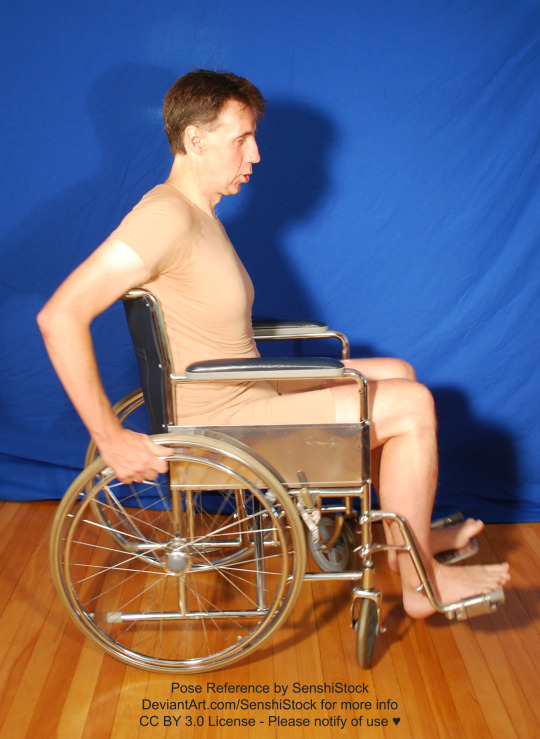
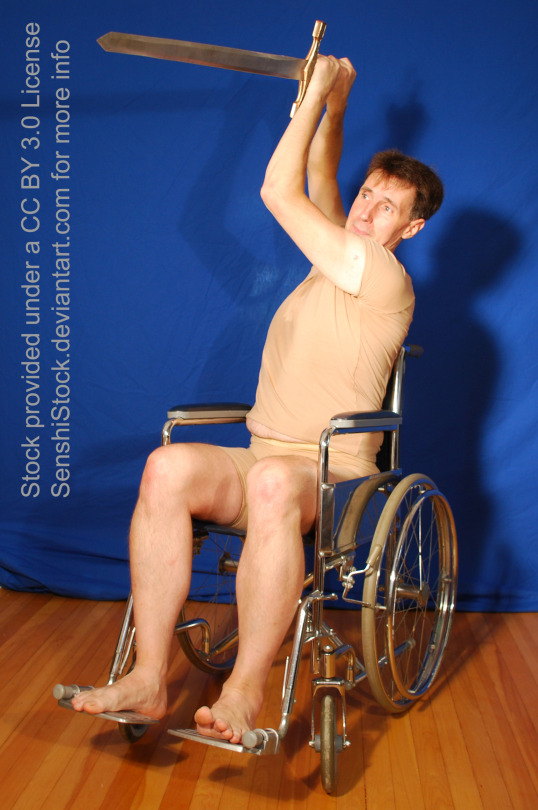
There's a few more from that shoot with Brian (the second model) that I don't have up yet anywhere. I will put those into a free set on Patreon soon. ♥
208 notes
·
View notes
Text
Science Museum Group changed offensive object tittle after getting my letter
here's the story about it:
Wonderful @solariium commissioned me wonderful victorian-era wheelchair user character to draw. Refs were provided, and one of the links was an object in online museum gallery - vintage wheelchair.
solariium, who is wheelchair user theirself, mentioned that tittle of the object is incorrect but it was good picture for the ref. i wondered "what's with the tittle?" looked in the link and saw
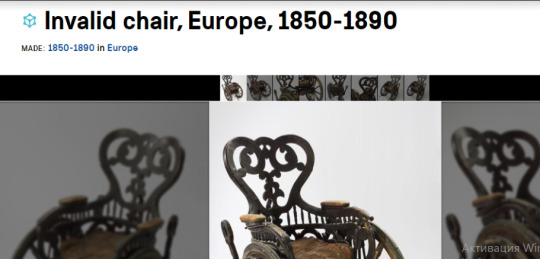
ID: screenshot of online museum collection, vintage old wheelchai object page. the tittle of wheelchair says: Invalid chair, Europe, 1850-1890. end ID
welp. incorrect indeed! [i* is outdated offensive term]
so i decided to make a special move

ID: my drawing of a character from anime "mob psycho 100" - Arataka Reigen. He holds a phone next to his ear, his face epression is very confident. It's all anime sparkles lights effects around him and text "REIGEN SPECIAL MOVE". end ID
and USE MY POWER
of writing emails
i don't have problems with writing emails, so i thought why not
and
https://collection.sciencemuseumgroup.org.uk/objects/co120657/carved-wooden-wheelchair-europe-1850-1890-invalid-chair

ID: screenshot of online museum collection, vintage old wheelchai object page. the tittle of wheelchair says: Carved wooden wheelchair, Europe, 1850-1890. end ID
it worked!
As human who made bunch of projects, i can say that keeping museum gallery is tone of work.
And tittle change - no, it's not just changing few letters.
Changing tittle of object in museum is similar to changing name of game file. Catalogs changes, maybe they have irl gallery, so new card, they probably have some code objects system related to tittles, and scientists, students, make reference to this object in their researches and articles and etc etc.
So, yeah, it * is * a lot of work. Also, they changed description, it now says that this object was "historically referred to as ‘invalid chair’". And i think it's good, because it is not erasing fact of people used this word, and it's addition to the progress context - we literally see now old term clarified as past, and new one, now, in the tittle.
(and yes, web link. i just saw that i* word still there. yeah, not perfect but still, considering things i said above - big work done)
I used some conversation strategy in case "this is offensive can you fix" will not be enough — started on positive attitude giving compliment on their collection being big and interesting, gave them extra argument on why this should be fixed (more actual search key words on this now are "vintage wheelchair", not "i* chair"). Then we had a little letters chain, where they answered politely too, and in about few days i got detailed answer on this, and yep, changed tittle.
And i think this shows, that if someone did mistake and someone noticed it and giving feedback on it, if both sides are interested in progress and making good changes, no matter how hard it is, sides can make a change, working together and being kind. And i think we should be more brave about making such connections!
Thanks again to @solariium and museum workers!
#small big changes#wheelchair#activism#i was writing this post in drafts for a month or smth like it's my diploma work#described
108 notes
·
View notes
Text
#wheelchair#wheelchair girl#paralyzedgirl#paragirl#paraplegic#amputee#amputeegirl#legless#no legs#dak amputee#dakamp#sexy stumps#stump love#stumps
81 notes
·
View notes
Text
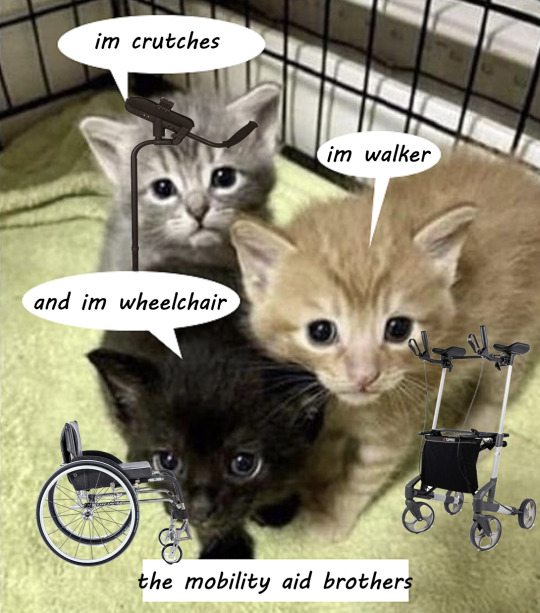
this meme is so niche
#HEDS#wheelchair#rollator#crutches#walker#mobility aids#cripplepunk#actually disabled#ambulatory wheelchair user#the kitten brothers
48K notes
·
View notes
Text
wheelchairs and canes and glasses and hearing aids and every single other disability aid should be free btw and if you disagree i hate you
#disability#wheelchair#cane#hearing aids#disability pride#🕸️#elbow/knee/etc. braces included#contact lenses#and i'm not talking cheap shit#i'm talking FITTED WHEELCHAIRS and HIGH QUALITY HEARING AIDS#and glasses with the perfect prescription#HOW is is that we have to PAY to live fairly
102K notes
·
View notes
Text
I'm not sure people realise just how important this second of television is.

Showing a person in a wheelchair crossing her legs. Using her legs.
After what rtd said about davros and rose in the unleashed episodes, this was 100 percent done on purpose.
When I go out in a wheelchair I am terrified to make it noticeable that I can use my legs. Because ... well we all know why and I'm not really articulate enough to go into everything.
But this. This right here. I doubt anyone who uses a wheelchair didn't have a doubletake. A glimmer. A KNOWING about just how important this tiny, insignificant action was.
And I'm fucking here for it
17K notes
·
View notes
Text
sure there’s a ramp, but is it steep? is there a curb at the top? is the ground uneven? do i need a key for the elevator? are the aisles and doorways wide enough? do i have room to turn? is there furniture and clutter in my way? is the carpet difficult to wheel on? can i open the doors myself?
accessibility to wheelchairs is more than just a ramp.
#disability#disabled#wheelchair#wheelchair user#wheelchair problems#accessibility#wheelchair accessible#cripplepunk#cripple punk#cpunk#disabled life#disabled struggles#disabled problems#disability life#disability struggles
15K notes
·
View notes
Text
"kill them with kindness" WRONG run them over in your wheelchair 👨🦼 👩🦼 🧑🦼 👨🦽 👩🦽 🧑🦽 👨🦼 👩🦼 🧑🦼 👨🦽 👩🦽 🧑🦽 👨🦼 👩🦼 🧑🦼 👨🦽 👩🦽 🧑🦽 👨🦼 👩🦼 🧑🦼 👨🦽 👩🦽 🧑🦽 👨🦼 👩🦼 🧑🦼 👨🦽 👩🦽 🧑🦽 👨🦼 👩🦼 🧑🦼 👨🦽 👩🦽 🧑🦽 👨🦼 👩🦼 🧑🦼 👨🦽 👩🦽 🧑🦽 👨🦼 👩🦼 🧑🦼 👨🦽 👩🦽 🧑🦽 👨🦼 👩🦼 🧑🦼 👨🦽 👩🦽 🧑🦽
#wheelchair#ambulatory wheelchair user#ambulatory mobility aid user#chronic illness#chronicpain#chronic disability#other chronic illness bs#chronic disease#chronically ill#disabled#fibromyalgia#undiagnosed chronic illness#disablity#chronic disorder#chronic pain#chronic fatigue#invisible illness#invisible disability#disability#physically disabled#disabilties#cpunk#cripple life#cripple problems#cripple punk#queer cripple#crip punk#undiagnosed chronic pain#joint pain#screenreader unfriendly
18K notes
·
View notes
Text


(More details in reblogs!)
Shopkeepers
Part 2
7K notes
·
View notes
Text
A snapshot of one morning, on a relaxed day with mild weather. Now imagine this when it's crowded or when it's raining or snowing.
Video description: POV from the lap of a wheelchair user. Very shaky. OP is going downhill on a fall day. Lots of trees and fallen leaves around. There are construction trucks to the left in the very beginning. Every now and then, you can see a German Shepherd on the left. Second obstacle shows a food robot crossing the sidewalk to drive in front of OP, but it stops suddenly and OP crashes into it. OP continues down the hill until she reaches another food robot, which is obstacle 3. This robot sits in the middle of the sidewalk while OP navigates around it. Then OP comes to a concrete ramp with iron railings, which is obstacle 3.5. It is very steep. After the ramp, OP goes to cross the street, where a black SUV blows through the crosswalk. Obstacle 4 is a ramp with red brick. OP struggles to move up and pauses at one point before continuing again to obstacle 5, where there is a big concrete building and manual doors. The German Shepherd service dog goes up to push the accessibility button multiple times to no avail. A student comes and opens the door, OP enters through two sets of doors into a hallway. Clip change to obstacle 6, OP is wheeling down a hallway and approaches a white elevator with out of order signs.
End of description.
#actually disabled#disabled#ambulatory wheelchair user#service dog#college#wheelchair#manual wheelchair#disability#inaccessibility#wheelie#city bus#college campus#campus bus#student#stem#women in stem#disabled scientist#disabled people in stem#service dog in training#dogs#german shepherd#assistance dog#shaky camera#flashing
8K notes
·
View notes
Text
i cant stress this enough, disabled people know their own limits. i fucking promise you. we are not being lazy or jerks because we won't do something YOU want us to do or something YOU THINK will make us feel better. it wont. stop.
#shoutout to my parents#physical disability#disabled witch#disability#disabled#chronic disability#chronically ill witch#chronic fatigue#chronic illness#chronic pain#cripple punk#crip punk#cripplepunk#actuallydisabled#actually disabled#wheelchair#wheelchair user#rambles#psa#mobility aid user#mobility aids#mobility aid#babe with a mobility aid#chronically ill
23K notes
·
View notes
Text
Literally all the shit rich people have turned into luxuries are stuff many disabled people need (or would need to manage their pain but can't afford it)
Comfy ergonomic chairs
Indoor pool/hot tub (therapy bath)
Massages on the regular
Aides (rich people call them servants)
Yea even a cook who makes you special meals (perfect for people with special dietary needs and for those with severe allergies, as well as people who are in too much pain or are otherwise unable to cook)
Elevators in your house (even small ones just for groceries, my rich aunt has one in her beach house!)
Rich people don't buy these for fun I hope but custom powerchairs are obscenely expensive. It pisses me off when I see another person invent "the wheelchair of the future!" Which then is literally never fucking used because none of us can afford it (and insurance definitely won't pay)
Indoor gyms or even personal exercise equipment. Hard to go out to a gym somewhere else when you're disabled, especially if you are immunocompromised
Outdoor spaces to relax in. It's literally vital for your mental health to at least see the outdoors. I'd rather be bedridden in a sunroom (with retractable blinds) than a shitty apartment with one tiny window.
There's even freaking health retreats these people go to regularly. There's a fibromyalgia retreat in new york where they basically take care of all your needs while trying different treatments and seeing which ones help. Either it's heaven or making money off of scamming desperate people who are able to scrape the money together to go.
Private planes, which I honestly think shouldn't exist, but one that specifically catered to people with disabilities (spaces for wheelchairs/other mobility devices, accessible handicapped airplane bathroom, anxiety reducing tools, trained medical personnel and care team)
Also customized cars, except instead of making gas guzzling racecars to joyride in while everyone else is trying to get to work, cars with electric ramps, lifts, doors, cars customized for someone with limb differences. Those cars where you can roll your wheelchair right up to the wheel. Fuck even self driving cars once they are no longer deathtraps.
Skincare products that are safe for sensitive skin like eczema but also actually work
Nice-looking clothes customized to fit limb differences, access points, look good in wheelchairs, colostomy bags, etc. while also being comfortable and not fast fashion.
Dental care!!! What the fuck why is this shit so expensive!! I don't want my teeth to fall out!! (Disabled people usually need more dental care bc we have a harder time keeping up maintenance)
Rich people go and splurge on all of these even though they don't need them while calling disabled people selfish for begging their insurance for even one of these.
#disability#chronic disability#chronic pain#chronic illness#fibromyalgia#spoonie#wheelchair#wrenfea.exe#i hope one day i can get even a small therapy tub#bc hot water therapy is one of the best things for my pain#and swimming is the only painless exercise i can do
4K notes
·
View notes
Text
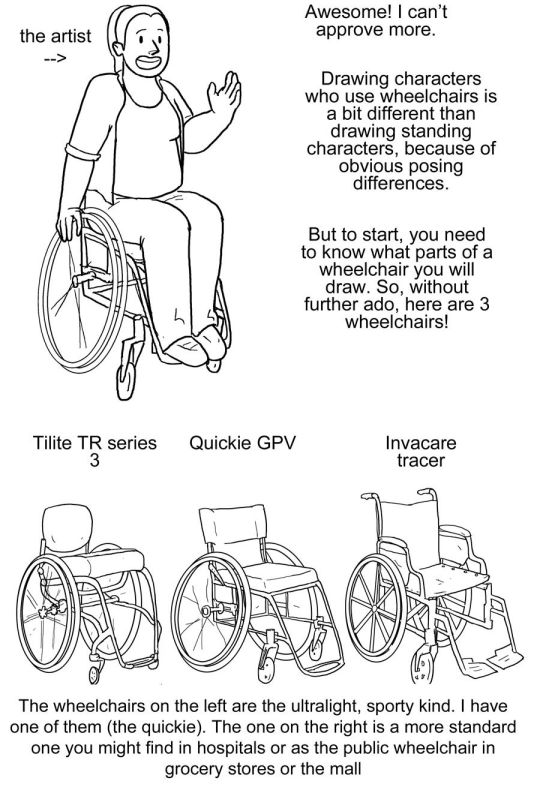
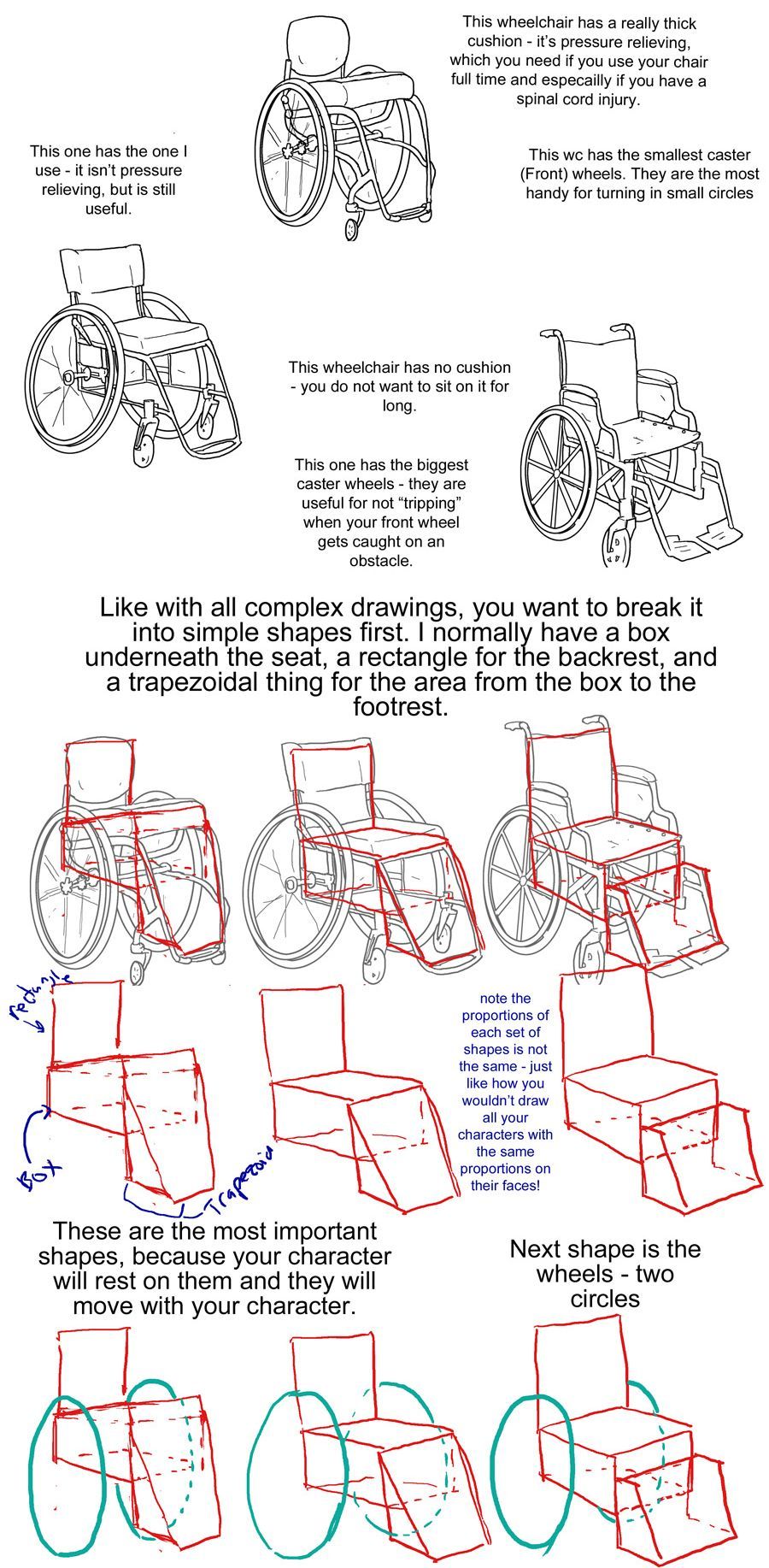
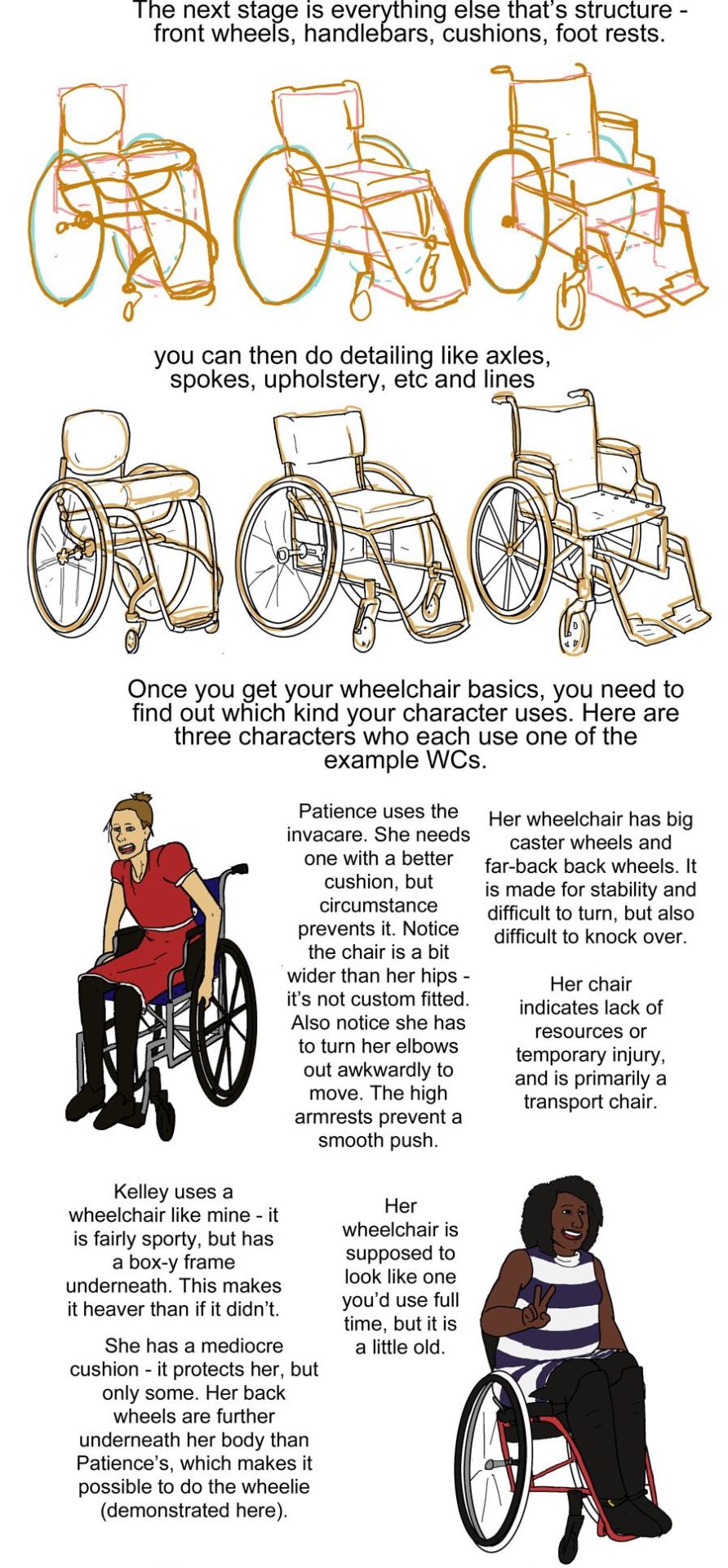
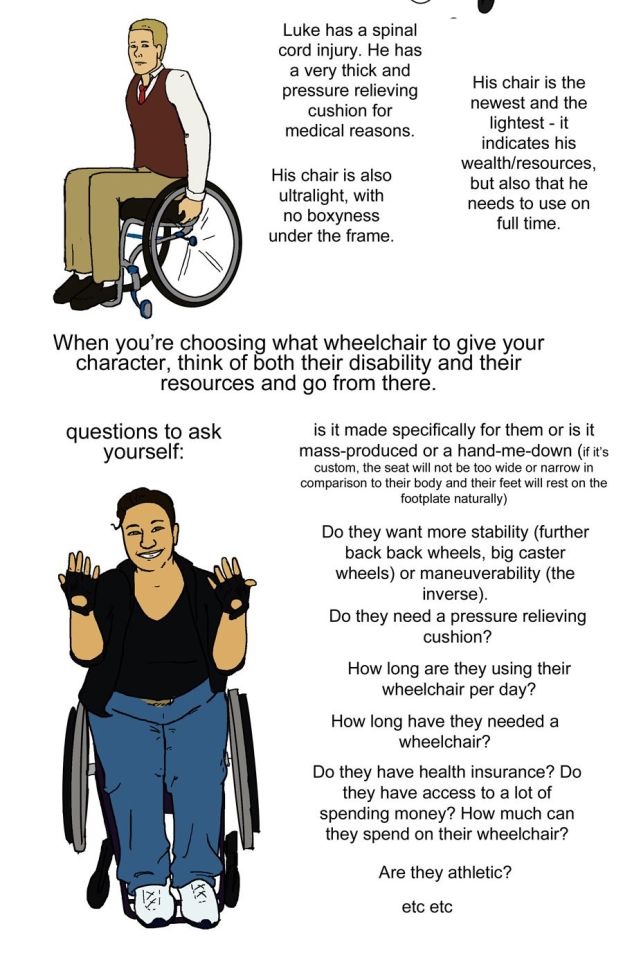
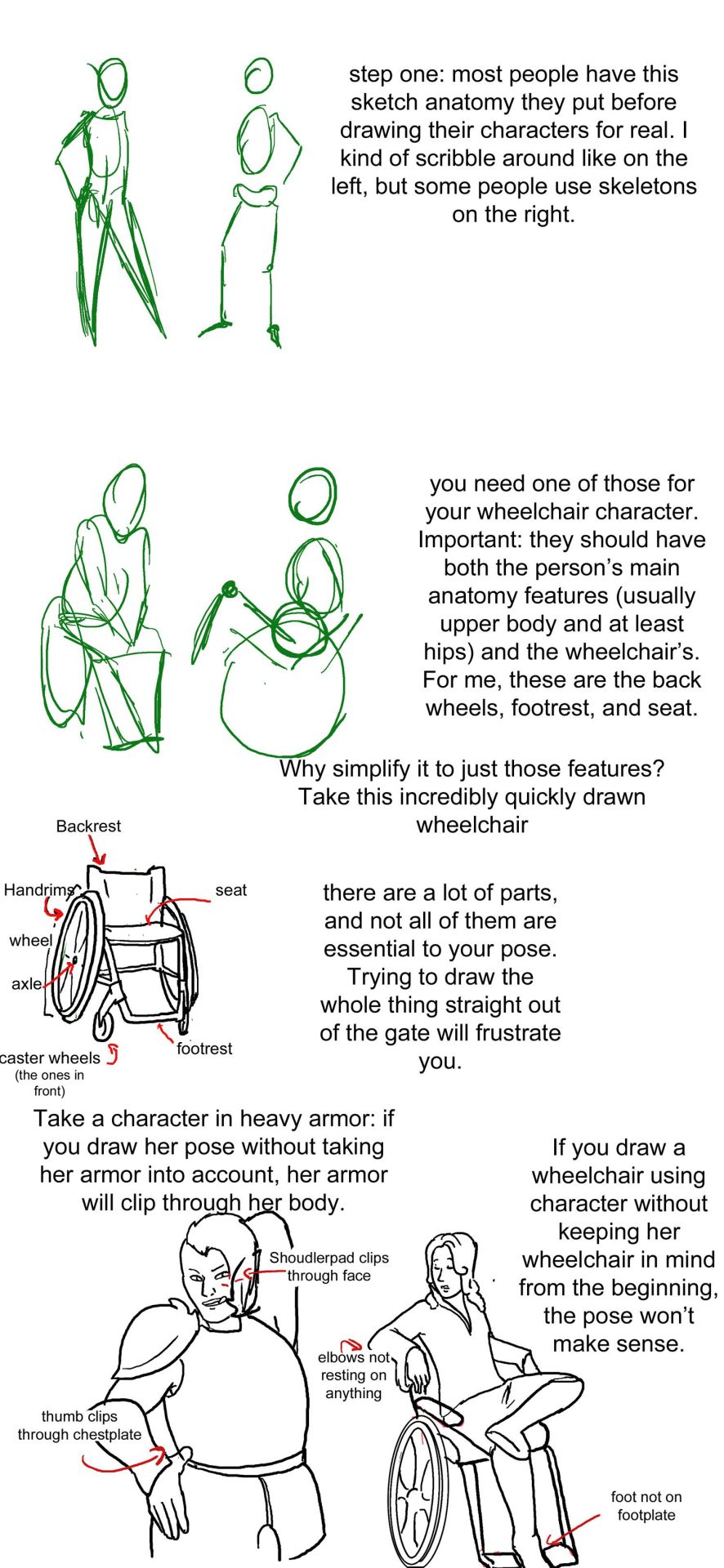
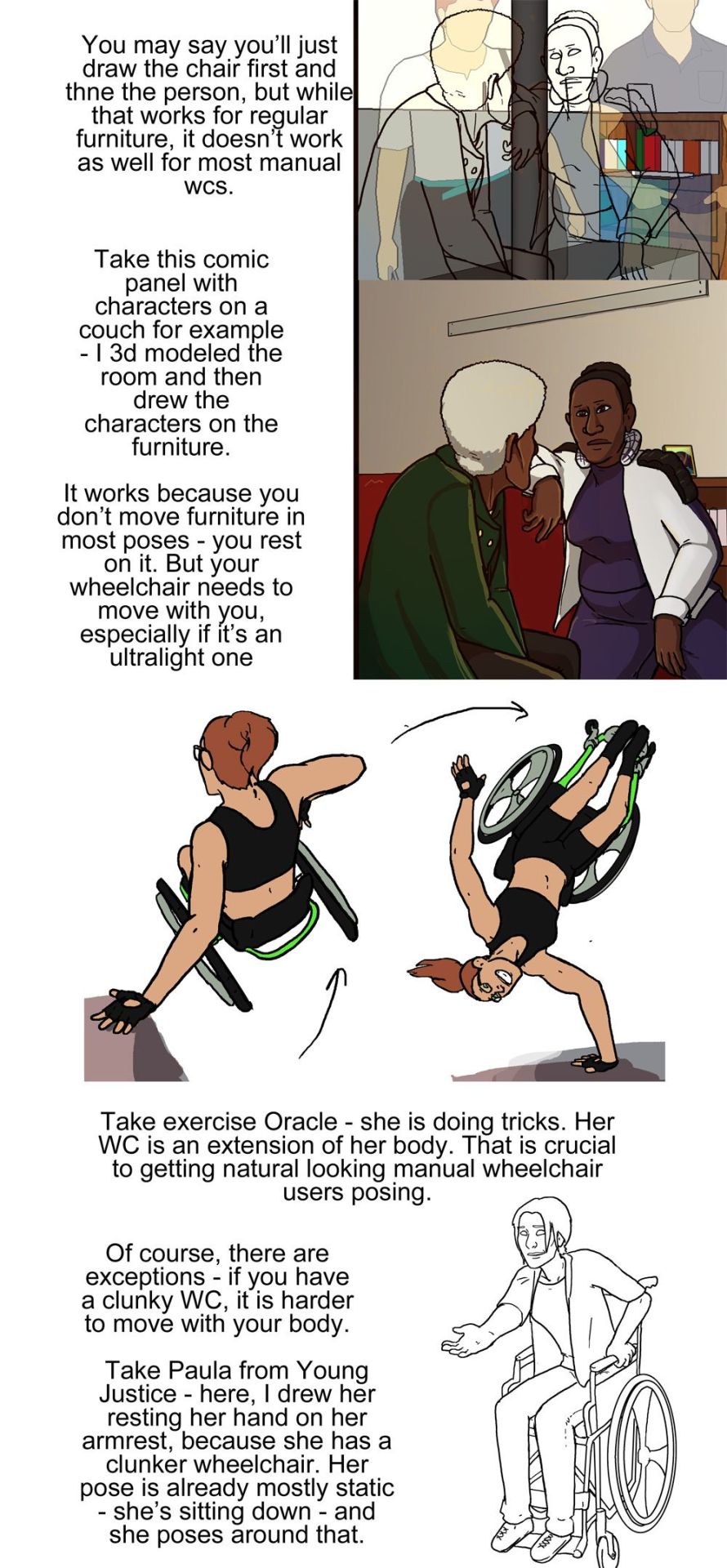
Manual Wheelchair Tutorial by Fade31415
So... I technically drew this 3 years ago but forgot to post it. I think I was going to clean up the end and make a nice recap, but I ran out of steam and then just left it as a wip for years. I got reminded of it because I was talking to a friend about how to draw wheelchairs today.
This covers most of what I view as the most common errors when it comes to drawing characters who use manual wheelchairs. I hope it helps you a lot.
Image description is in alt text, but there is a back up image description under the cut in case that does not work for some reason
[image description: a 4 picture long wheelchair tutorial. the background is white and the text, when it appears, is black and in calibri. each step will be labeled with "Step #" and a description of the drawing next to it, and "text" and then the text that is written to explain it to follow.
Step one text: So, you want to draw a character who uses a manual wheelchair? Awesome! I can't approve more. Drawing characters who use wheelchairs is a bit different than drawing standing characters, because of obvious posing differences. But to start, you need to know what parts of a wheelchair you will draw. So, without further ado, here are 3 wheelchairs!
Step one image: a simplified drawing of a chubby woman sitting in a quickie GPV manual wheelchair and resting her hand on the handrim of one of the wheels. this is labeled "the artist"
step two: next there is a lineart drawing of three wheelchairs. one is a tilite TR series 3. this is an ultralight wheelchair with a bucket seat (the back is lower than the front), a big cushion and a short backrest that kind of contours to the back of the person who would sit in it. the caster wheels (front wheels) are very small and the footrest is just two little metal bars. next image is a quickie GPV. this is also an ultralight wheelchair with a low back, but its caster wheels are slightly larger, the back has regular upholstery (it does not look like it was made to conform to the back of the person who sits there) and the frame is boxier -- there is no bar underneath the seat where the wheels would attach, rather each wheel is attached to the side of the chair. the next wheelchair is an invacare tracer. it is how most people imagine wheelchairs when they hear 'wheelchair'. it has no cushion and it has a high backrest with handles. it has high armrests that would be comfortable to rest your elbows on if you were just sitting. the wheels are not bicycle wheels like the previous two but are rather plastic. it has big footrests and big caster wheels.
text: the wheelchairs on the left are the ultralight, sporty kind. I have one of them (the quickie). the one on the right is a more standard one you might find in hospitals or as the public wheelchair in grocery stores or the mall.
step three: first is text to accompany the tilite. "This wheelchair has a really thick cushion - it's pressure relieving, which you need if you use your chair ufll tiem and especially if you have a spinal cord injury. This wc has the smallest caster (front) wheels. They are hte most handy for turning in small circles." next there is text to accompany the quickie gpv: "This one has the one I use -- it isn't pressure relieving, but is still useful." next is text to accompany the invacare: "this wheelchair has no cushion - you do not want to sit on it for long. This one has the biggest caster wheels - they are useful for not 'tripping' when your front wheel gets caught on an obstacle.”
step four text: like with all complex drawings, you want to break it into simple shapes first. I normally have a box underneath the seat, a rectangle for the backrest, and a trapezoidal thing for hte area from the box to the footrest. these are the most important shapes, because your character will rest on them and they will move with your character.
step four image: the lineart of each wheelchair has been put on reduced opacity, so we can see the square representing the backrest of each seat (the square is the smallest for the tilite and biggest for the invacare), the box for each seat and area underneath it, and the trapezoid for the footrests. the next step labels the images of these simplified shapes as the lineart is removed. "Note the proportions of each set of shapes is not the same - just like how you wouldn't draw all your characters with the same proportions on their faces!"
step 5: we see the same shapes to form the wheelchair, but now with blue circles drawn where the back wheels would be.
text: next shape is the wheels - two circles
step six: next we see the wheels and shapes have been reduced in opacity and the basic structure of everything about each wheelchair: footrests, caster wheels, upholstery details, axles has been drawn on in orange.
text: the next stage is everything else that's structure - front wheels, handlebars, cushions, footrests.
Step seven: we see the lineart on top of the lowered opacity sketch.
text: you can then do detailing like axles, spokes, upholstery, etc and lines
step eight: next we see three drawings of different characters. there is patience, a skinny white woman sitting in a blue invacare wheelchair. kelley, a slightly chubby black woman wearing a stripey dress sitting in a red quickie gpv wheelchair and doing a wheelie while smiling. then luke, a white man with short blond hair wearing khaki pants. he is sitting in a tilite chair.
text: once you get your wheelchair basics, you need to find out which kind your character uses. here are three characters who each use one of the example WCs. patience uses the invacare. she needs one with a better cushion, but circumstance prevents it. Notice the chair is a bit wider than her hips - it's not custom fitted. Also notice she has to turn her elbows out awkwardly to move. the high armrests prevent a smooth push. her wheelchair has big caster wheels and far-back back wheels. it is made for stability and difficult to turn,but also difficult to knock over. Her chair indicates a lack of resources or temporary injury, and is primarily a transport chair
kelley uses a wheelchair like mine - it is fairly sporty, but has a box-y frame underneath. this makes it heaver than if it didn't.she has a mediocre cushion - it protects her, but only some. her back wheels are further underneath her body than Patience's, which makes it possible to do the wheelie (demonstrated here). her wheelchair is supposed to look line one you'd use full time, but it is a little old.
luke has a spinal cord injury. he has a very thick pressure relieving cushion for medical reasons. his chair is also ultralight, with no boxyness under the frame. his chair is the newest and lightest - it indicates his wealth/resources, but also that he needs to use on full time.
step nine: just a drawing of me sitting in my wheelchair holding my hands up to show fingerless wheelchair gloves. we're looking at me from above.
text: when you're choosing what wheelchair to give your character, think of both their disability and their resources and go from there. questions to ask yourself: is it made specifically for them or is it mass-produced or a hand-me-down (if it's custom, the seat will not be too wide or narrow in comparison to their body and their feet will rest on the footplate naturally). do they want more stability (further back back wheels, big caster wheels) or maneuverability (the inverse). do they need a pressure relieving cushion? how long are they using their wheelchair per day? how long have they needed a wheelchair? Do they have health insurance? do they have access to a lot of spending money? How much can they spend on their wheelchair? are they athletic etc etc
posing steps:
step one: a sketch of two people standing up. one just shows the outline of a person's body, with legs that are ind of triangle shaped, the other shows a sketched pelvis and rib cage to go along with the bones of the legs and arm. text: step one: Most people have this sketch anatomy they put before drawing their characters for real. I kind of scribble around like on the left, but some people use skeletons on the right.
step two: there are now too sketched pictures of people in wheelchairs. one shows lightly traced human form (arms articulated, curve for a stomach, legs that are kind of triangle shaped and pointing down) sitting in a wheelchair that is just the sketch of footrests and wheels. the other sketch shows the sketch of a body with a circle for hips and an oval for a rib cage and the person doing a wheelie (lifting the front end of the wheelchair off the ground and leaning back). their wheelchair is also sketched out and defined by a circle for their wheels and 2 lines, 1 of the seat and 1 for the backrest. text: you need one of those for your wheelchair character. important: they should have both the person's main anatomy features (Usually upper body and at least hips) and the wheelchair's. for me, these are the back wheels, footrest, and seat. why simplify to just those features? Take a look at this incredibly quickly drawn wheelchair.
step three: there is a lineart drawing of a manual wheelchair with slightly cambered (angled towards the seat) wheels, a backrest, and a footrest. the frame is light and there are no handlebars. there are labels pointing to different parts of the wheelchair: Backrest, handrims, wheel, axle, seat, footrest, and caster wheels (the ones in front). text: there are a lot of parts, and not all of them are essential to your pose. trying to draw the whole thing straight out of the gate will frustrate you.'
step four text: take a character in heavy armor: if you draw her pose without taking her armor into account, her armor will clip through her body. if you draw a wheelchair using character without keeping her wheelchair in mind from the beginning, the pose won't make sense.
step four image: next we see two lineart drawings of different characters. one is a bulky woman wearing plate armor. her hand is on her hip and she is trying to scratch her back with the other hand. there is the label "shoudlerpad clips through face" and "thumb clips through chestplate." the next drawing shows a woman in a wheelchair with one foot rested on her knee and her arms rested back, such that they would be rested on the back of a regular chair, but the back of her wheelchair is not wide enough for them to actually be resting on anything. the text here reads "elbows not resting on anything" and "foot not on footplate"
step five: there are two images, one is lineart on top of a 3d modelled apartment with sketchup, the other is a colored in version of that lineart with the background also colored in and no longer a 3d modelled screencap two characters, one old woman wearing a green jacket and one younger woman wearing a white shirt and blue undershirt, are sitting on a couch. the old woman is leaning forward and the young woman is resting her arm on the couch. behind the young woman is a bookshelf.
step five text: you may say you'll just draw the chair first and then the person, but while that works for regular furniture, it doesn't work as well for most manual wcs. take this comic panel with characters on a couch for example - I 3d modeled the room and then drew the characters on the furniture. it works because you don't move furniture in most poses - you rest on it. but your wheelchair needs to move with you, especially if it's an ultralight one.
step six image: there is a flat color drawing of barbara gordon in her wheelchair. she is wearing a black sportsbra and black shorts. in the first image we see she is doing tricks in her chair, zooming through the air (as if she has just launched herself off the ground in a skater park or somethign) while her left hand is resting on a structure and her right hand is heading towards the right handrim. the next image shows her right hand planted on the ground and her chair and body above her, such that she is briefly doing a one-handed handstand, but the motion line indicates that she is moving and this will not last. her left arm is near the handrim of her left wheel.
text: take exercise Oracle - she is doing tricks. Her WC is an extension of her body. That is crucial to getting natural looking manual wheelchair users after posing.
step seven: we see a lineart drawing of paula from young justice. she is sitting in a standard manual wheelchair with high armrests (goes up to the bottom of her ribs probably) and a high backrest (goes up to just below her shoulderblades). she is setting her hand on the armrest, leaning forward, and holding her other hand out.
text: of course, there are exceptions - if you have a clunky WC, it is harder to move with your body. Take Paula from young Justice - here, i drew her resting her hand on her armrest, because she has a clunker wheelchair. her pose is already mostly static - she's sitting down - and she poses around that.
#wheelchair#wheelchair user#manual wheelchair#wheelchair tutorial#tutorial#drawing tutorial#my art#disabled characters
49K notes
·
View notes
Text
EVERYBODY STOP WHAT YOURE DOING I HAVE THE BEST NEWS! I GOT A WHEELCHAIR!!!!!!!! I CAN LEAVE THE HOUSE ALONE AGAIN, I CAN BE SAFE AND INDEPENDENT AND HAPPY AND SEE MY FRIENDS AND HAVE A LIFE AGAIN!!!!!!
#wheelchair#wheelchairs#zoommmm#♿️#🦽#cpunk#cripple punk#queer cripple#cripple posting#disabled#diability#functional neurological disorder#fnd#joy#disabled joy#chronic illness#chronically ill#chronic pain#fibromyalgia#postural orthostatic tachycardia syndrome#potsawareness#potsie#pots#spoonie#spoons#physically disabled#physical disability#cripplepunk#crip punk#actually disabled
2K notes
·
View notes
Text
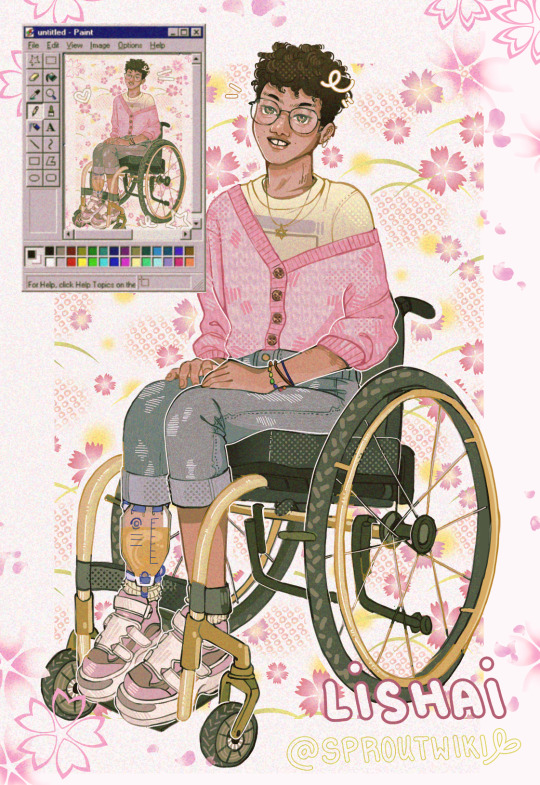
Lishai 🌈🌸♿️🩷🪴 [ID in alt-text]
He has PPMS and uses an intermittent catheter! There is way too much stigma (from both disabled and non-disabled people) about incontinence, catheters, and bladder issues. It’s not “gross”. The only “gross” thing is being judgmental of disabled people for something they cannot control and keeps them alive.
#my art#art#original characters#disabled artist#disabled characters#disabled oc#wheelchair user#catheter#ms#multiple sclerosis#illust#illustration#babe with a mobility aid#disabled and cute#wheelchair
3K notes
·
View notes
Text
Tips for writing and drawing Wheelchair using characters: Your character's wheelchair can tell us a lot about them
When you first start learning character design, you'll often be told something to the effect of "use your character's outfit to tell us more about them" - and this same principles can be applied to a disabled character's mobility aids.
Mobility aids like wheelchairs, to many disabled people, are a part of us. They can be an extension to a person's body and chances are, if you're going to be using this piece of equipment every day for the foreseeable future (or at least for a good amount of time for the foreseeable future), it's going to start reflecting some aspects of your personality, your interests, your passions, especially when you remember, a lot of people get their wheelchairs custom built for them.
You can use your character's wheelchair to tell us a lot about them without ever needing to show/describe them directly.
Let me show you two examples:

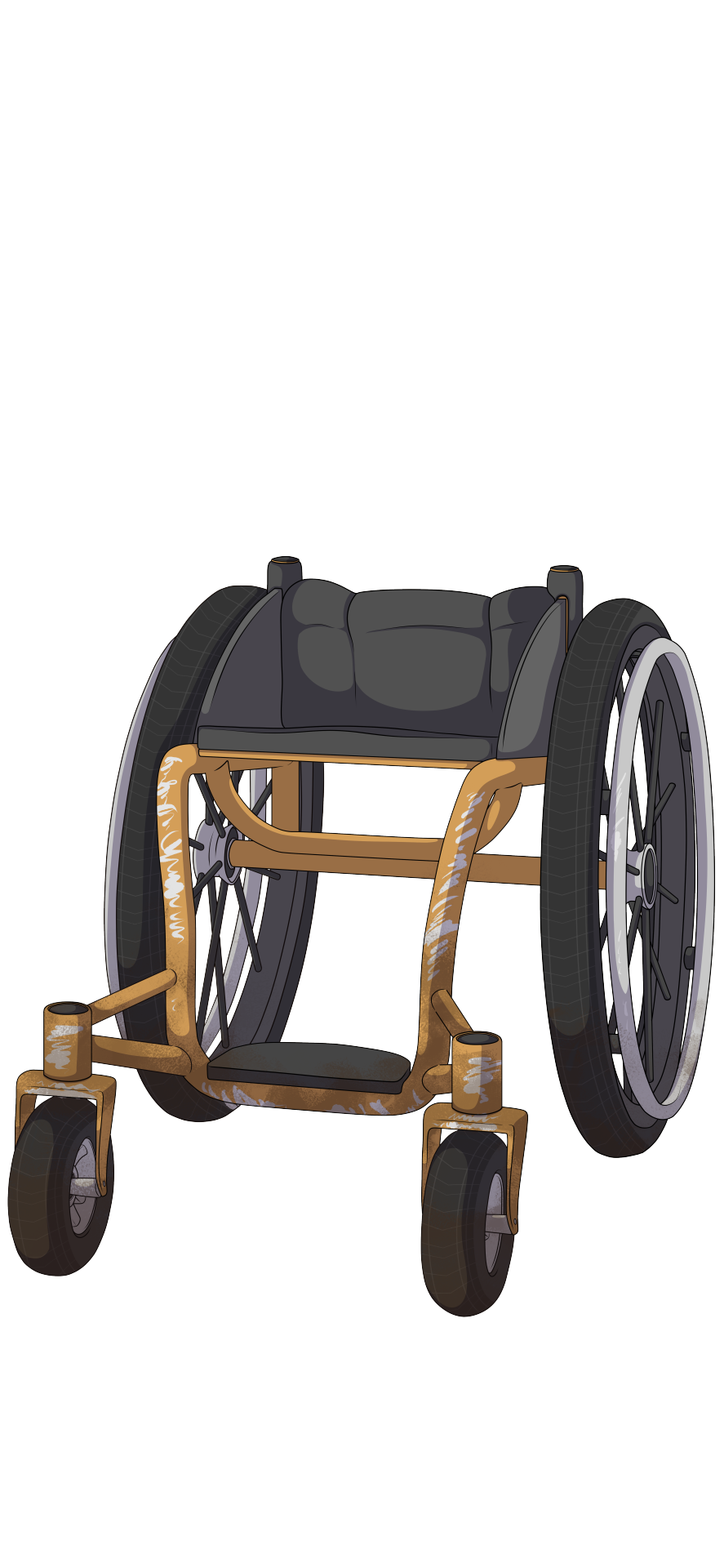
Take a look at these two wheelchairs. they're similar in shape and build, but still pretty different to each other. Can you make some guesses about their users based only on what's shown here?
intended answers below:
Please note, the following points are all generalisations and the real world is rarely this simple. This is to demonstrate how to use disability aids to contribute to your character's design, not how to make assumptions about real people in real life.
So here are some similarities between the chairs:
Both wheelchairs have ridged frames, this means the wheelchair can't be folded in any way. These kinds of chairs can imply a few different things depending on the person. They are typically lighter, sturdier and more durable, and indicate the person probably will be using the wheelchair for a long time and/or has the money to get something built to last (or lives in a place where cost not an issue due to universal/subsidised access to healthcare). They are also typically better to travel with when flying, as they are less likely to be broken by airport security/staff.
Both wheelchairs also lack anti-tip wheels, which are a third set of wheels that extend from the back of the chair. Them not being present could indicate the person is likely pretty confident in their ability to use the chair without worrying about tipping out. It could also indicate they are in an environment where the anti-tips could be more of a hazard than a help, such as on rough terrain.
So lets look at some specifics for the green wheelchair:
Take a look at the wheels. The front wheels are pretty small and appear to be solid, while the back wheels appear to be quite narrow (compared to the orange chair anyway). This indicates the user likely lives somewhere with decent accessibility like a (well funded) city where they are unlikely to encounter unpaved/dirt roads/grass. Small front wheels and thin back wheels are good for manoeuvrability and a smooth ride over even terrain, but they will get stuck as soon as bumps appear, so this probably isn't an issue for this person.
While its a bit hard to tell unless you have seen other similar wheelchairs, this wheelchair is very long in the front, meaning the footplate and front wheels are further away from the seat than most. There could be a few reasons for this. One either indicates the person has very long legs, or a lack of motion in their knees, making it harder to bend their legs. This is moves the chair's centre of gravity forward by a decent amount, making it harder to tip back, which could indicate the person's legs are very light. You tend to see this most often in the wheelchairs of bilateral leg amputees, who are at a greater risk of tipping backwards due to a lack of weight at the front of the chair (even if they wear their prosthetics).
The colour of the chair is bright. This could simply be the character's favourite colour, or maybe this colour has some significance to them?
There are stickers on the side of the chair relating to the Paralympics. This could indicate the person is a fan, or perhaps had some involvement in the games?
The wheelchair has handles on the back, but they are able to be folded down. This is a popular feature for people who are independent enough to go out on their own, but still want to have the option for some help. folding down the handles also deters random strangers from grabbing at you (an unfortunately common experience for wheelchair users).
There is some mild paint scratching to the front of the wheelchair, but nothing too noticable. This is typical of older chairs and people who are a little rough on their chairs. Maybe they've had a few stacks and falls throughout the years, probably going a decent speed.
Ok, now let's look at the orange chair
This wheelchair has very large, inflatable front wheels, and very thick back wheels. This will make the chair slower and less manoeuvrable on flat/even surfaces, but much, much easier to push on rough terrain. This is supported by the amount of mud on the wheelchair.
The seat on this wheelchair tilts upwards slightly. This is called a bucket (or according to an old basketball teammate of mine, a dump-truck lol). This is a feature you typically see in wheelchairs made for people with spinal injuries who are unable to move their legs and engage their lower bodies or core to help keep them stable.
The back of this chair is very low, indicating that if this wheelchair user has a spinal injury, it's probably pretty low on their spine, likely fairly close to the hips, making the person a low-level paraplegic. Higher-level paraplegics and quadriplegics usually need a higher back to help support them and keep them from flopping over, since all the muscles below their place where their spine broke either doesn't work, or is significantly weaker. Higher backs though can get in the way of pushing and reduce mobility, so people who need less support will likely opt for a lower back rest.
This wheelchair has no handles, which indicates the user is probably very independent and doesn't need a lot of help getting around.
The paint on this wheelchair is very scratched up, showing the person is very tough on their wheelchair and doesn't care to get the paint touched up.
This wheelchair has no breaks. This is very common on chairs with larger tiers as they don't tend to be as effective, but also on many outdoor wheelchairs, for two reasons. One is because they are made for rough terrain, so chances are, you aren't going to go far without a big push to get you moving. The second reason is that to get over large bumps and obsticals in a wheelchair, it can be helpful to do very large pushes using the top and front of the wheel. When pushing a normal chair, most people will only use the top section of the wheel to push since it's closest, but these big pushes that use the front of the wheel make it easier to push, since you can benefit from downwards momentum. However, this is also where the breaks are located on most wheelchairs, which can create a hazard. I've lost entire fingernails by them getting snagged on the breaks when pushing this way. So if you live somewhere where the breaks are not going to be helpful to you often, it makes sense to not get them.
And here are the characters who own these wheelchairs
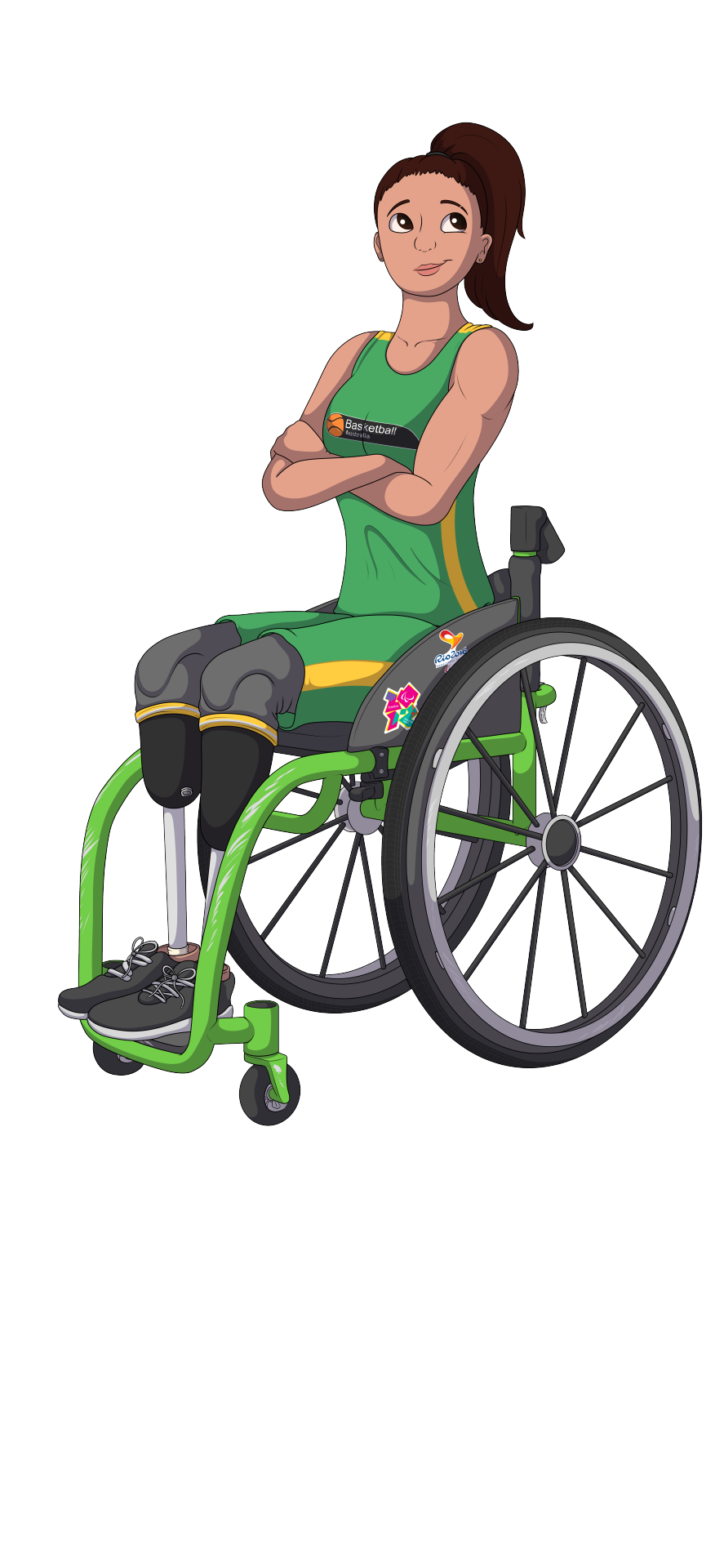
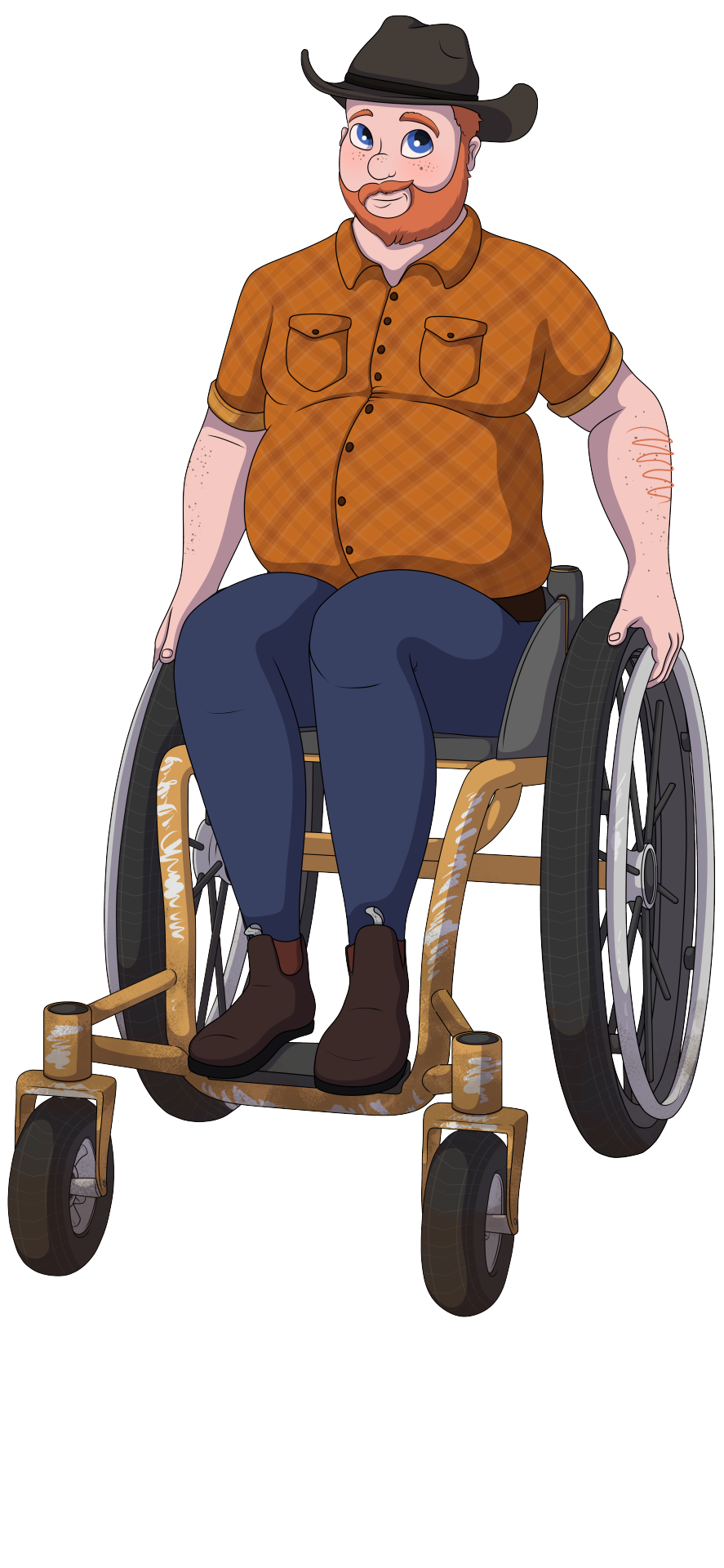
The owner of the green wheelchair is an amalgamation of a few people I knew from when I played wheelchair basketball. They're a bilateral leg amputee, and judging by their outfit (The Official National Wheelchair Basketball uniform for Australia), they're an elite athlete. This wheelchair is not the one they play sport in, but it still needs to be durable enough to withstand the rough treatment of airport staff when traveling, as well as heavy day-to-day use that comes with being an active person. While it needs to be rough, the person also seemed to want to prioritise speed and manoeuvrability, and likely doesn't need to worry about rough terrain too much, so they probably live in a major city.
The owner of the orange chair was inspired by a family friend of mine. They live on a farm, and need a chair that can handle life in those conditions, rough terrain and all. This comes at the cost of speed and manoeuvrability on smoother terrain, but honestly, anyone who's lived in the country knows you won't find many of those around there anyway, so that's not too big of a sacrifice. They are paraplegic, are very confident in their ability to use their wheelchair, and probably doesn't need help too often, but still benefit from some extra stability support from the raised seat on their chair.
Conclusion
Once again, these are generalisations, and in real life there are always exceptions, but I hope this helped demonstrate what I meant when I said you can use your character's wheelchair to tell us more info about them if you're smart about it.
I originally planned to do a whole series of these, showing a wider variety of wheelchairs and the people who they belong to, but I guess I kind of forgot because they've been sitting, abandoned on my hard drive for the last 2 years 😅. If that's something you folks would be interested in seeing though, let me know, I'd happily revive the series lol.
#Writing Disability with Cy Cyborg#id in alt text#long post#writing disability#disability#disabilities#disabled#physical disability#wheelchair user#physically disabled#wheelchair#character design#character illustration#character concept#Designing Disabled Characters#writers on tumblr#writing#writing community#writblr#writerblr#writing advice#writing tips#writing resources#art reference#artists on tumblr#artblr#illustrator#visibly disabled#disabled and proud
4K notes
·
View notes